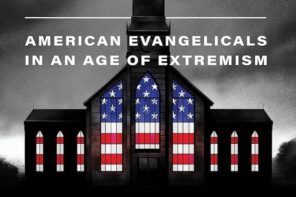What would Supreme Court Justice Tom Clark think of public school Bible courses that taught that Jewish festivals are actually typological predictions of Jesus, that the “African races” are descendants of Noah’s cursed son Ham, that biblical stories about angels may have referred to extraterrestrial visitors, or that Genesis’ six-day creation story is scientifically accurate if interpreted correctly?
Clark is the justice who penned the Court’s majority opinion in the 1963 case of Abington Township School District v. Schempp, known primarily for prohibiting public school officials from reading Bible verses to captive student audiences, though it also hinted at the possibility of constitutionally appropriate study of religion in public education:
It certainly may be said that the Bible is worthy of study for its literary and historic qualities. Nothing we have said here indicates that such study of the Bible or of religion, when presented objectively as part of a secular program of education, may not be effected consistently with the First Amendment.
However, the above examples from the state of Texas—where 57 school districts and three charter school systems offered high school Bible courses in 2011-2012—suggest that 50 years after the gavel dropped in Schempp, some schools are still struggling when it comes to discussing the Good Book “objectively.”
Recently, citing the Texas Public Information Act, Texas Freedom Network contacted those schools and asked that they provide it with their course materials. TFN then asked me to examine the accumulated boxes of syllabi, tests, handouts, lecture notes, and PowerPoint presentations for academic quality and evenhandedness toward diverse religious sensibilities (full disclosure: I was compensated for my efforts, though I’m otherwise unaffiliated with TFN).
I was interested in the extent to which schools succeeded in meeting the bar set for them by federal district courts; namely, that discussions of religion should neither promote nor disparage particular religious beliefs, nor favor religion or non-religion over the other. The First Amendment Center’s The Bible & Public Schools: A First Amendment Guide and the Society of Biblical Literature’s Bible Electives in Public Schools: A Guide provided a starting point from which to consider whether a course’s approach could be considered nonsectarian.
The results of the study, presented in the new report Reading, Writing & Religion II: Texas Public School Bible Courses in 2011-12, were decidedly mixed. On the one hand, eleven school districts did quite well, offering courses that were careful not to promote one religious perspective over all others, and which encouraged critical thinking, careful communication skills, and creativity. Twenty-eight districts had courses that reflected a combination of successful and unsuccessful elements, sometimes achieving a nonsectarian approach, but other times lapsing—sometimes considerably—into religious bias of the kinds noted by federal courts. The courses of twenty-one districts were thoroughly religious in nature, sometimes openly promoting particular beliefs.
The most successful courses typically had several characteristics in common. They recognized that no single religious tradition had a monopoly on the Bible, but that Protestants, Roman Catholics, Eastern Orthodox Christians, and Jews all have very different collections they called by that name. Likewise, they taught students that different religious traditions approached the biblical text with different lenses, and that interpretations some readers take for granted (the traditional Christian understanding of the serpent in the Garden of Eden as Satan, for example) are rejected by others.
They took the Bible seriously as an important historical source without assuming it was historically accurate, and they discussed its ethical materials without presenting them as authoritative for the students. They also acknowledged the existence and importance of competing religious beliefs regarding the Bible and its stories without adopting one perspective as their guiding framework. When they discussed Judaism, they examined it as a religion in its own right, not merely as Christianity’s foil or outdated predecessor. And they treated the Bible as a set of texts worthy of rigorous study and careful examination, and developed correspondingly challenging exercises for their students. Such courses are positive examples for others to emulate.
Unfortunately, those courses remain in the minority, and Bible classes more often displayed elements such as the following:
Explicit Theological Claims
Several districts blatantly promoted belief in the Bible’s divine inspiration. For example, the “correct” answer to the question:
What is the difference in the five books of Torah and the other sixty-one books of the Bible?
is:
The first five… were dictated. The other sixty-one were inspired.
A PowerPoint slideshow in another district simply stated that, “The Bible is the written word of God.” Some districts couched their discussion of biblical inspiration in the familiar terms of conservative Protestant notions of biblical inerrancy; as one district’s PowerPoint presentation explained: “Since God is perfect and infallible, an inspired book is absolutely infallible and errorless in its facts and doctrines as presented in the original manuscript.”
Biblical Literalism
Literalistic reading strategies often went hand in hand with claims of biblical inspiration. The Bible was presented as flawlessly accurate in regard to both science and history. One teacher’s treatment of Genesis focused on ways to reconcile young-earth and old-earth theories by suggesting that each of the six days was unusually long, or that a lengthy gap elapsed between Genesis 1:1 and 1:2-3. Another teacher’s resource materials included a religious tract claiming that NASA had discovered a missing day in time that proved Joshua 10’s story of the sun standing still. One district’s slideshow on archaeology’s verification of the Exodus story concluded with this observation:
Sad to say mainstream anti-God media do not portray these true facts in the light of faith But prefer to sceptically [sic] doubt such archaeological proofs of the veracity & historicity of the Biblical account one of the most accurate history books in the world[.] “Commit your way to the LORD; trust in him, and he will act.” (Psalm 37:5)
Judaism Interpreted through Christian Eyes
When it comes to scripture shared by Jews and Christians—the Hebrew Bible/Old Testament—many courses present the material primarily as a series of prophetic predictions about Jesus. A chart in one class titled “Jesus and the Genesis Flood” highlighted purported similarities between the two, including this observation: “As there was only one Ark where people must be saved, There is only one man by which we must be saved today: the man Jesus Christ.”
A study guide for another course’s final examination summarized Genesis’ primordial history thusly: “Meanwhile God was fulfilling his promise to bring a savior by developing a godly line of people through Seth, from whom came Noah and his blessed son Shem.” Some courses adopted wholesale a Christian theology of supersession, which holds that Christians have replaced Jews as God’s people. Note the first-person language and Sunday School tone in a worksheet on the New Testament book of Hebrews: “Could the Old Law make anyone perfect? What made the old covenant obsolete? If we sin willfully, what no longer remains?” A reading utilized in another district explained why God had rejected the Jews (at least for now):
It wasn’t the killing the Messiah that put the Jews at odds with God. After all He came to die for them. No. It’s that in killing Him, they refused to let his death pay for their sins so He could save them. This had the effect of making His death meaningless to them. That’s what severed the relationship.
Academic Quality
A surprising number of courses asked little more of students than to memorize Bible verses or learn basic details of biblical stories so that they could fill in the blanks on tests. Some made very questionable choices about the use of classroom time, such as the course that spent two days watching “the historic documentary Ancient Aliens,” which presents “a new interpretation of angelic beings described as extraterrestrials,” and then asked students to write a paper on it. Or the one where students watched multiple episodes of Hanna-Barbera’s The Greatest Adventure: Stories from the Bible.
The number of Bible courses in Texas has gone up since 2007, when Texas passed a law encouraging schools to offer them. Texas is not alone in having such a statute; in recent years, Georgia, Tennessee, Oklahoma, and Arizona have passed similar laws, and Bible bills are currently making their way through the Wyoming and Arkansas legislatures. While these laws typically urge teachers to avoid promoting or disparaging religious views they give them little guidance on how that might be accomplished.
For example, although the Wyoming bill originally called for the creation of course standards (to be vetted by the state attorney general), and appropriate teacher training, those provisions were deleted by a House committee before passing the bill on to the Senate. Arkansas’ bill actually prohibits districts from developing course guidelines beyond the very meager provisions included in the legislation itself. If passed in their current forms, these bills would send teachers into a legal and political minefield without a map.
The reality is that in most cases such laws are not necessary for Bible courses to be offered in public schools. Districts across the country offer Bible courses, state law or not, and school officials often do not monitor their contents. The results, as the examples above illustrate, are often egregious, with 49 of 60 Texas districts found to have at least some elements of religious favoritism. Hopefully, as more abuses like these are revealed, the scales will fall from our eyes and we’ll be moved to enforce Abington v. Schempp in time for its 50th anniversary.




